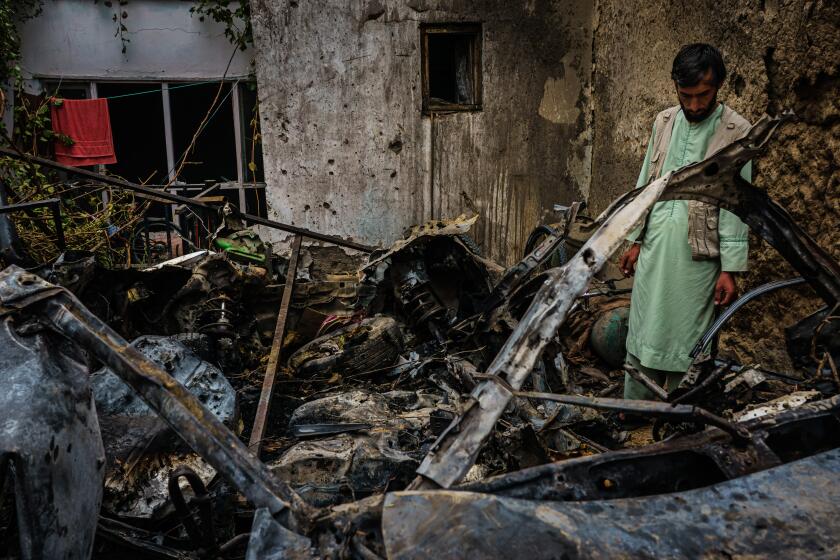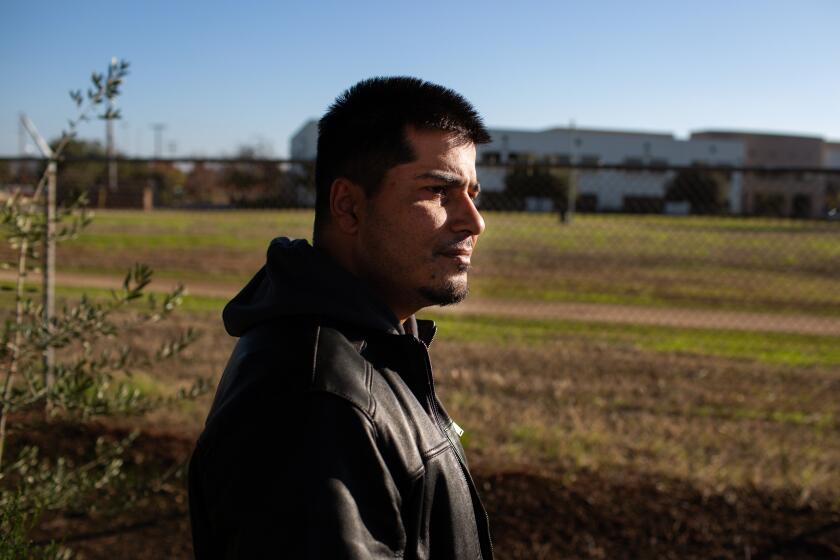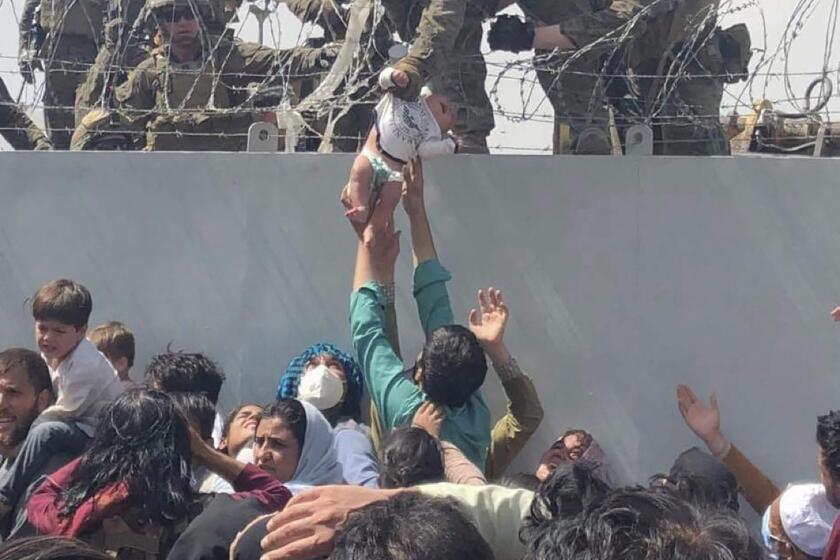Aid workers struggle to save millions of Afghans from starving or freezing to death

- Share via
PUL-E-ALAM, Afghanistan — A flickering flame of paper, rags and random twigs is the only heat Gulnaz has to keep her 18-month-old son warm. The boy is barely visible beneath his icy blanket as his mother begs on a bitterly cold highway on the road to Kabul.
The 45-mile stretch of highway is flanked by snow-swept hills. Occasionally, a driver slows his car and shoves a bill into the 28-year-old woman’s bare, dirt-caked hand. She sits for hours on the highway median, just beyond a bump in the road that slows traffic.
Gulnaz’s 16-year-old sister, Khalida, sits nearby. Both are hidden under voluminous blue burqas. By the end of the day, Gulnaz, who gave just the one name, says they might make 300 afghanis (about $2.85). But most days it is less.
The Taliban’s sweep to power in Afghanistan in August drove billions of dollars in international assistance out of the country and sent an already dirt-poor nation, ravaged by war, drought and floods, spiraling toward a humanitarian catastrophe.
In recent weeks, it has been the bitter winter cold that is devastating the most vulnerable and has international aid organizations scrambling to save millions from starving or freezing because they have neither food nor fuel. For the poorest, the only heat or means of cooking is with the coal or wood that they can scrounge from the snowy streets or that they receive from aid groups.
“The extent of the problem now in Afghanistan for people is dire,” said Shelley Thakral, spokeswoman for the World Food Program in Afghanistan. “We’re calling this a race against time. We need to get to families in very difficult, hard-to-reach areas. It’s winter, it’s cold, the snow.”
The $308 million would flow through independent humanitarian groups, the White House said while also pledging to send 1 million COVID vaccine doses.
The cost of the humanitarian effort is staggering. Thakral said the World Food Program alone will need $2.6 billion this year.
“Break that number down. That’s $220 million a month, that’s 30 cents per person per day, and that’s what we’re asking for. ... We need the money because we need to reach people as quickly as we can,” she said.
Earlier this month, the United Nations launched an appeal for more than $5 billion to help the devastated nation.
It’s estimated that roughly 90% of Afghanistan’s 38 million people are dependent on aid, and the United Nations says nearly 3 million are displaced in their own country, driven from their homes by drought, war and famine.
Iran, which is home to 3 million Afghans, with thousands more arriving daily, is sending more and more refugees back — into the hands of the Taliban.
In 2020 alone, 700,000 Afghans became displaced, many living in desperate conditions on the outskirts of cities, in parks and open spaces — wherever they could erect a makeshift shelter.
Gulnaz migrated to central Logar province from the northern province of Kunduz, where her husband had been a shoemaker. But his work dried up with war and the coming of the Taliban, and “we have come here,” she said as she sat with her sister on the side of the highway linking Logar’s capital, Pul-e-Alam, with Kabul.
“We have no heat at home, and every day, whether it is raining or snowing, we come and sit here,” she said.
In Pul-e-Alam, where temperatures in January and February can drop into single digits, thousands of men and women line up in the bitter cold to collect a World Food Program ration of flour, oil, salt and lentils.
The survivors of an errant drone strike in Kabul that killed 10 members of their family are frustrated no U.S. troops will face disciplinary action.
The WFP surveyed the city to find the neediest, giving each a voucher to collect rations, but word spread quickly through the snow- and mud-covered streets that food was being distributed, and soon scores of men and women had gathered, pushing and pleading for rations. Fights broke out among some in the crowd, and security forces tried to cordon off those without vouchers to one side.
Each day for a week this month, the WFP distributed rations to as many as 500 families a day, said Hussain Andisha, who manages the distribution. Most people in Logar province are desperate, he said.
As he spoke, four women in burqas slipped past the men at the gate taking vouchers. None had a ration card, but they pleaded for food. One woman, who gave her name only as Sadarat, said her husband was a drug addict — a devastating problem that has mushroomed in the last two decades, with as many as 1 million people, or 8% of Afghanistan’s population, counted as addicts, the U.N. says. Afghanistan produces more than 4,000 tons annually of opium. the raw material used to make heroin.
“I don’t know where he is. I have no food for my children. Please, I need something,” she said.
Emal Salarzai helped teach elite Afghan troops. Now his parents are on the run from the Taliban, and he can’t find any way to aid them in escaping.
Like hundreds of thousands of Afghans, poverty and conflict drove Sadarat and her five children from their rural home in Logar province’s Charkh district to the capital, 24 miles away.
Shouting from behind Sadarat, another woman, Riza Gul, said she had 10 children and a husband who earned less than $1 a day as a laborer on the days he can find work.
“What can we do? Where can we go?” she pleaded.
Andisha said the WFP’s January distribution would provide staples to 2,250 families in Pul-e-Alam, home to about 23,000 people. Already the WFP has surveyed the seven districts of Logar province and begun distribution in four. Roads are deep in snow, and passage for the hundreds of trucks transporting the food is slow going and can be treacherous.
Start your day right
Sign up for Essential California for the L.A. Times biggest news, features and recommendations in your inbox six days a week.
You may occasionally receive promotional content from the Los Angeles Times.
Andisha said the need was desperate and becoming more dire with each passing day.
“Even from the first day we arrived here, the situation has worsened. People have no jobs,” he said, adding that women who were working before the Taliban took power “now cannot work in government departments.”
“It is certain the situation will worsen,” he said.
The Taliban administration in Logar has not interfered in the WFP’s aid work, Andisha added, and has provided security at distribution sites.
Advocates want to expand a fast pass for legal entry known as humanitarian parole to certain Afghans who remain in danger.
Thakral, the WFP spokeswoman, said donations go directly to the people, even as aid organizations and the international community struggle to address one of the world’s worst humanitarian disasters without dealing directly with Afghanistan’s Taliban rulers.
“People come first and that’s important to remember in this humanitarian crisis,” she said. “We work independently from the de facto government so the assurance there is that any donation received will be given directly to the people.”
More to Read
Sign up for Essential California
The most important California stories and recommendations in your inbox every morning.
You may occasionally receive promotional content from the Los Angeles Times.


















